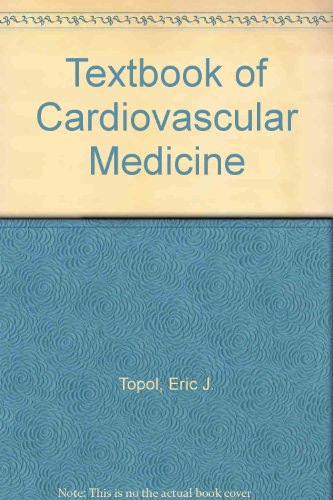Items related to Textbook of Cardiovascular Medicine

Eight sections cover preventive cardiology; clinical cardiology; cardiovascular imaging; electrophysiology and pacing; invasive cardiology and surgical techniques; heart failure and transplantation; molecular cardiology; and vascular biology and medicine. Each chapter includes frank, authoritative comments on current controversies and pioneering insights into future developments. This edition features a completely revised section on invasive cardiology and surgical techniques and updated information on drugs, devices, and genetics. Four new chapters discuss end-of-life care...medical errors and quality of care in cardiovascular medicine...percutaneous coronary intervention...and new techniques in interventional cardiology: radiation, emboli protection, and PMR.
The book contains the core information that is essential for day-to-day clinical practice. The CD-ROM contains expanded versions of these chapters--plus 18 additional chapters...full-color images...heart sounds...and approximately 250 angio and echo loops. Icons in the book guide the reader to the electronic material.
"synopsis" may belong to another edition of this title.
Is this the time for another textbook of cardiology, and is such a book necessary? Recent years have seen a proliferation of books on specific problems in cardiovascular medicine, new textbooks, and fresh editions of standard textbooks; thus, the market appears to be well served. Why another textbook?
The Textbook of Cardiovascular Medicine is a multiauthored, 2732-page contribution, written, edited, and orchestrated by distinguished experts in their fields. It contains 98 chapters, organized into eight major sections: preventive cardiology, clinical cardiology, cardiovascular imaging, electrophysiology and pacing, invasive cardiology and surgical techniques, heart failure and transplantation, molecular cardiology, and vascular biology and medicine.
Each chapter is structured in a user-friendly fashion, with a table of contents, a glossary, tables of major findings and results, and algorithms, as well as discussions of strategies, a personal perspective, and a very brief glimpse at future developments. Throughout the book, special emphasis is placed on graphic displays of data on outcomes (life tables on mortality, morbidity, and prognosis) from studies likely to set global therapeutic standards -- an approach that stresses the point of evidence-based medical education. The best examples are probably the sections on preventive and clinical medicine and on heart failure and transplantation.
The chapters are sufficiently well illustrated, although the illustrations are not in color. Original images (ultrasound images, radionuclide scans, histologic and macropathological illustrations, and some schematic diagrams) would clearly have benefited from color reproduction. References are generously supplied and in most cases recent; only a few updates and corrections are in order. Besides an occasional odd grouping of chapters in sections (e.g., a chapter on diseases of the aorta is embedded in the last section, on vascular biology, next to a discussion of angiogenesis and the biology of restenosis), the compilation of sections and chapters is devoid of serious redundancy.
This ambitious textbook does not just cover academic cardiovascular medicine in a concise and comprehensive fashion (as we would expect, considering the well-established competitors). By design, it blends rather than highlights important modern issues, such as medical economics, quantitative clinical evidence, medicolegal issues, use of data bases, assessment of quality of care, the effect of managed care, and the role of the consulting cardiologist, with both a well-balanced coverage of the historical aspects of preventive and clinical medicine and an up-to-date, in-depth coverage of all the diagnostic and therapeutic facts pertinent to cardiovascular disease. Moreover, the careful, comprehensive integration of molecular cardiology and vascular biology is a distinctive advantage and underlines the modern academic orientation of this textbook.
Overall, this new book stands up well in comparison with the leading textbooks. The Textbook of Cardiovascular Medicine is unique, with a modern design that integrates, in an optimistic fashion, the concept of evidence-based medicine, data on clinical outcomes research, and the changing socioeconomic environment with the emerging fields of molecular medicine and genetics. On the verge of a new millennium, it is about time for another textbook; the authors and editors are to be congratulated.
"Surprise, surprise, good things come twice" could have been the motto of the editors and publisher of the Textbook of Cardiovascular Medicine, since they have also produced Comprehensive Cardiovascular Medicine, which reached my desk while I was finishing the review of the Textbook of Cardiovascular Medicine. As if the Textbook were not sufficiently comprehensive, the "comprehensive" version contains several hundred more pages and 23 additional chapters that were obviously considered not important enough to include in the Textbook; otherwise, there is no difference between the two books. Apparently, in an effort not to overload the Textbook and not to alienate some contributors, the editors chose to offer the "comprehensive" version. For the reader, however, this solution provides no substantial advantage, especially considering the enormous difference in price between the two books. I believe one good (concise and comprehensive) textbook with a CD-ROM would be of great service to the reader.
Reviewed by Christoph A. Nienaber, M.D.
Copyright © 1998 Massachusetts Medical Society. All rights reserved. The New England Journal of Medicine is a registered trademark of the MMS.
"About this title" may belong to another edition of this title.
- PublisherLippincott Williams & Wilkins
- Publication date1997
- ISBN 10 0781718635
- ISBN 13 9780781718639
- BindingHardcover
- Number of pages2760
(No Available Copies)
Search Books: Create a WantIf you know the book but cannot find it on AbeBooks, we can automatically search for it on your behalf as new inventory is added. If it is added to AbeBooks by one of our member booksellers, we will notify you!
Create a Want
